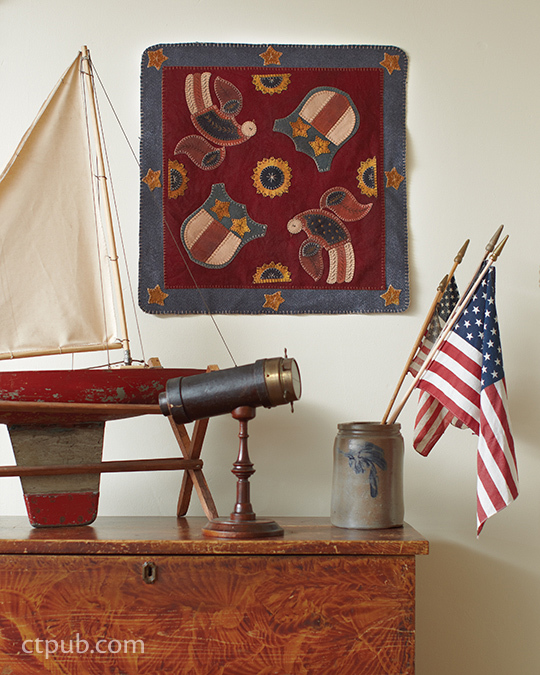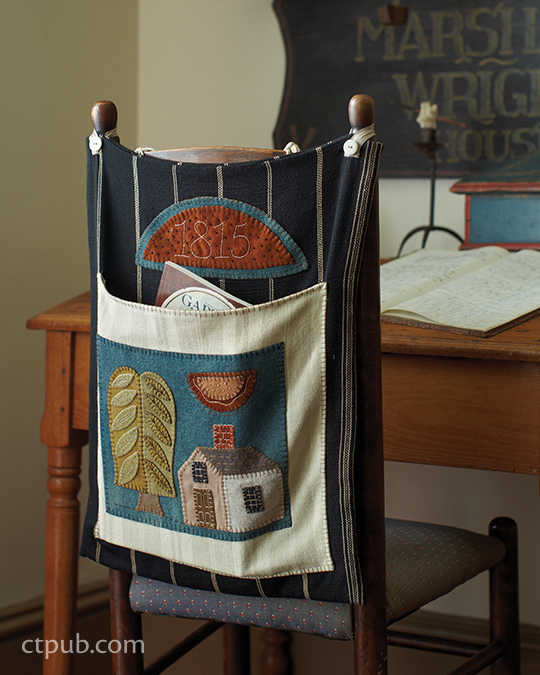Early American Traditions: A Conversation with Rebekah Smith of Wool Appliqué Folk Art
Posted by Katie Van Amburg on Jun 8th 2015
I recently had the pleasure of working on Rebekah L. Smith’s Wool Appliqué Folk Art: Traditional Projects Inspired by 19th-Century American Life. Rebekah is an award-winning folk artist with a passion for early American art and wool appliqué. Her remarkable eye for color is visible in the hand-dyed, repurposed wool she uses in her work. 19th-century art is a part of Rebekah’s everyday life: her own home was built in 1838, and she and her family continually work to restore it.

The well-researched Wool Appliqué Folk Art contains fourteen traditional projects. Rebekah also provides a section on repurposing, handling, dyeing, and storing wool. The book has beautiful styled photography, along with inspirational photographs of antiques.
I asked Rebekah a few questions about her art, process, and book. The answers might surprise you!
KVA:
In your book, you write that you want to inspire your readers rather than give them a book full of rules. What first inspired you to start making wool appliqué art based on 19th-century styles?
RS:
I came upon a photograph in a magazine of a wonderful old children's bed cover completely stitched in wool. It depicted animals in a crazy quilt pattern. Knowing that I couldn't buy the original, I decided to try my hand at making a smaller version for my daughter. That was the beginning of my love for wool appliqué.
KVA:
I love the way you write about inspiration for your projects, too. You mention being inspired by antique paper valentines and German-immigrant frakturs.* Do you look for these kinds of inspiration, or do they find you?
* Pen and watercolor documents used to commemorate baptisms, births, and marriages
RS:
They found me as a result of my parents’ passion for early Pennsylvania-German folk art. They are our roots and we spent many a summer in Eastern Pennsylvania tracking down these works in museums and antique shops. Now I spend time with my family doing the same.
KVA:
How long have you used wool in your work? What is your favorite thing about wool appliqué?
RS:
Wool came into my life about 10 years ago. I had long worked as a folk art painter and once I discovered wool, I realized it was an extension of my painted work. I often refer to it as painting with wool. Color is one of my favorite parts of working in wool appliqué, dyeing the wool and designing with the results.
KVA:
Do you ever take liberties with 19th-century design to make it your own? Do you have any advice about how to create authentic folk art while maintaining one’s individual style?
RS:
Yes, I feel my work is inspired by, but not reproductions of, original pieces. Also, what inspires me spans several centuries and I take what I like from different time periods for my designs.
Research is important so that one can be aware of what motifs are authentic. Then, adapt those motifs to fit your style. Color is very important. I prefer the time-worn hues where a piece looks as though it has survived 100 years.

KVA:
You sometimes use natural dyeing techniques on your wool. You mention having used black walnuts, goldenrod, and onionskins to make dyes! What is the most unusual thing you’ve tried to use as a natural dye? How well did it work?
RS:
The wild grapes that grow on our property gave me an ugly grey. I also tried some weeds with small orange flowers, as I had read somewhere their roots gave you a beautiful rusty orange. I must have had the wrong plants, as I got nothing from them but dirty water.
KVA:
You have a large variety of projects in your book, from table rugs to pillows to bags. What is your favorite type of project to make?
RS:
Table rugs are at the top of my list. There is an endless variety of motifs to use and endless ways of putting designs together. They are also a stunning way of displaying your work.
KVA:
If you could travel to any decade and place in 19th-century America, when and where would you go?
RS:
Eastern Pennsylvania, around 1800. There were so many artisans working there. It would also be fascinating to follow their migration west into Ohio as they brought their craftsmanship with them. Also, I would like to see our 1838 Ohio house when it was new.
Wool Appliqué Folk Art by Rebekah L. Smith is available now here!









